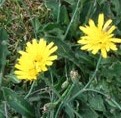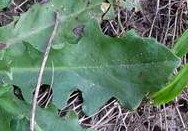 A native of North Africa, Europe, and Asia, this perennial weed is now widespread in the US where it grows in disturbed soil such as roadsides, pastures, and lawns. It goes by several common names including and false dandelion and flatweed,. The common names refer to characteristics of the weed; the basal rosette of leaves and flowers of catsear are very similar to that of the true dandelion; the leaves are hairy and resemble a cat’s ear; and the rosette of leaves lies so close to the ground that grazing animals have difficulty eating it.
A native of North Africa, Europe, and Asia, this perennial weed is now widespread in the US where it grows in disturbed soil such as roadsides, pastures, and lawns. It goes by several common names including and false dandelion and flatweed,. The common names refer to characteristics of the weed; the basal rosette of leaves and flowers of catsear are very similar to that of the true dandelion; the leaves are hairy and resemble a cat’s ear; and the rosette of leaves lies so close to the ground that grazing animals have difficulty eating it.
Description
 A basal rosette of leaves grows from a fibrous root system but often with some roots that thicken to resemble taproots. The leaves are hairy, up to eight inches long and two inches wide, and have rounded lobes. The stems are six to twenty four inches tall, branched and bear single bright yellow flowerheads, 1-3″ ´wide and composed entirely of ray flowers. The flowers appear all summer long and give way to seed heads of many small orange to brown achenes with white hairs that facilitate wind pollination. Plants look similar to true dandelions (Taraxacum officinale) but a close examination of the plants reveals their differences; catsear has branched stems while the true dandelion has a single hollow stem and the leaves of catsear are hairy and have rounded lobes while the leaves of the true dandelion are sharp toothed and not hairy.
A basal rosette of leaves grows from a fibrous root system but often with some roots that thicken to resemble taproots. The leaves are hairy, up to eight inches long and two inches wide, and have rounded lobes. The stems are six to twenty four inches tall, branched and bear single bright yellow flowerheads, 1-3″ ´wide and composed entirely of ray flowers. The flowers appear all summer long and give way to seed heads of many small orange to brown achenes with white hairs that facilitate wind pollination. Plants look similar to true dandelions (Taraxacum officinale) but a close examination of the plants reveals their differences; catsear has branched stems while the true dandelion has a single hollow stem and the leaves of catsear are hairy and have rounded lobes while the leaves of the true dandelion are sharp toothed and not hairy.
Control
Plants can be dug but care must be taken to remove at least several inches of the root or plants will re-sprout. Mowing is ineffective because the plants grow so close to the ground that only the flowering stalk is cut by mowing. Many herbicides are ineffective against this weed but those containing 2-4 D are useful if applied in the spring when the plants are young and vulnerable.